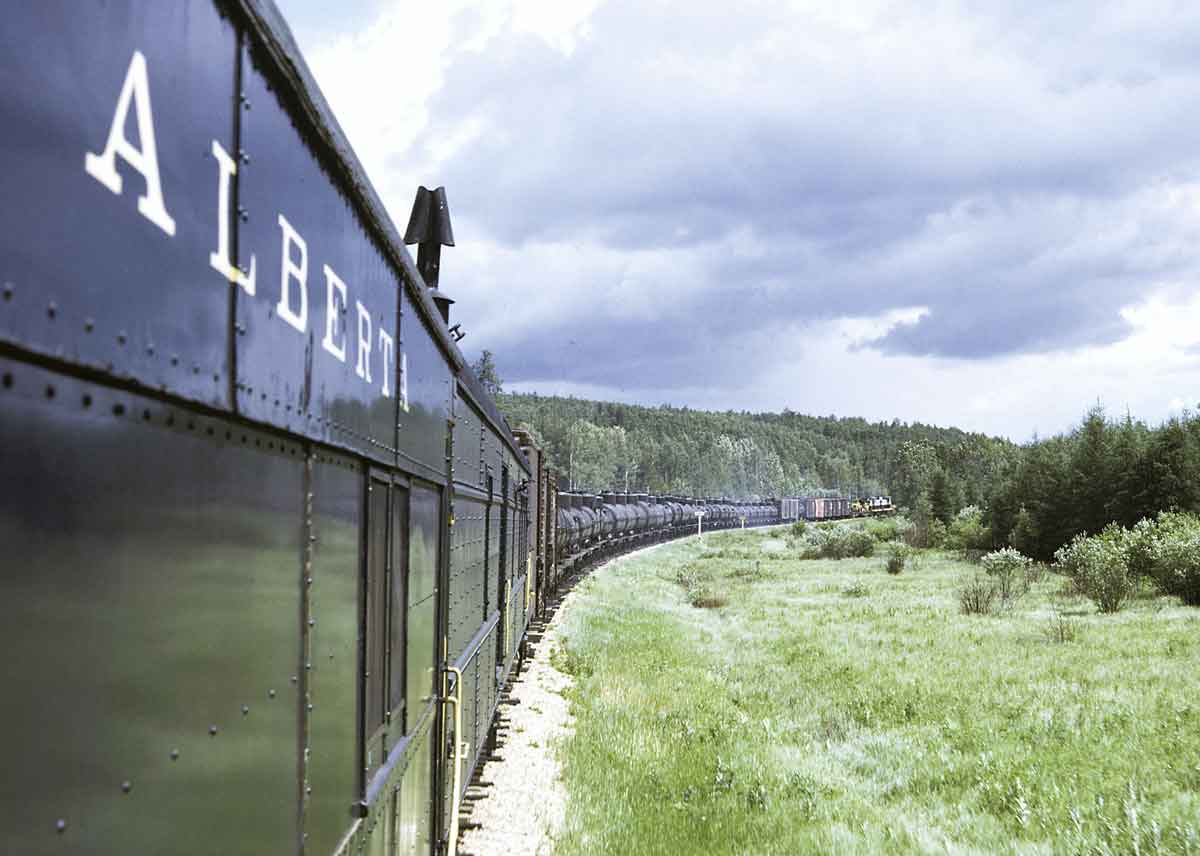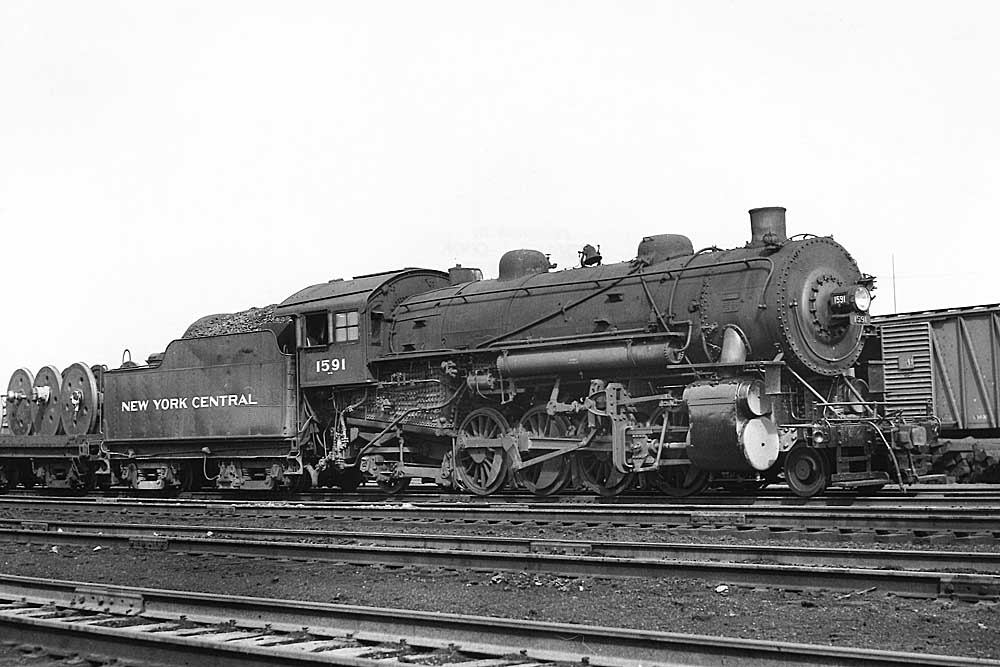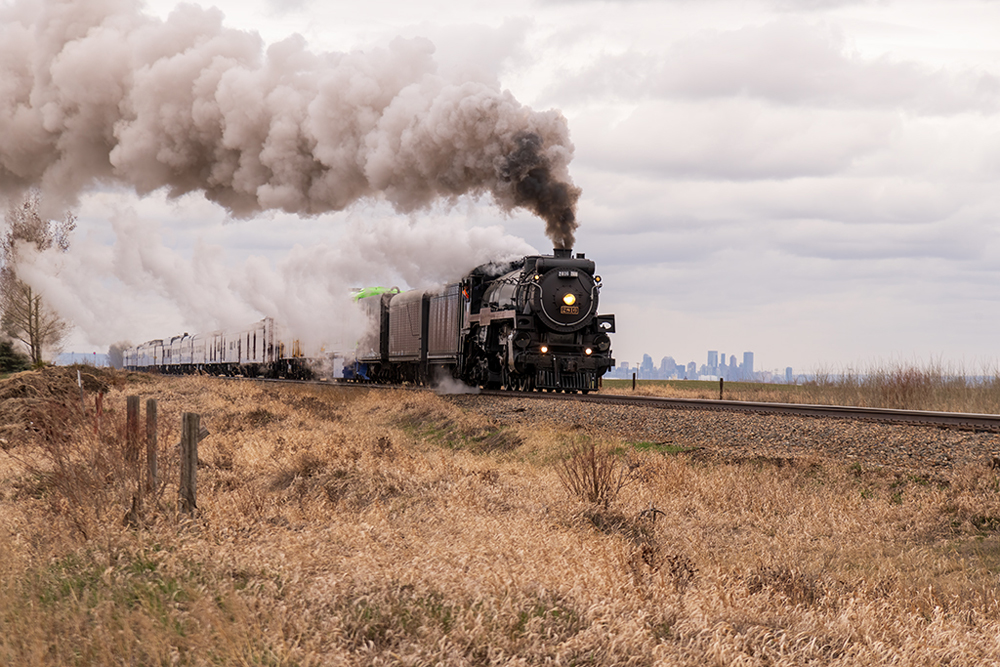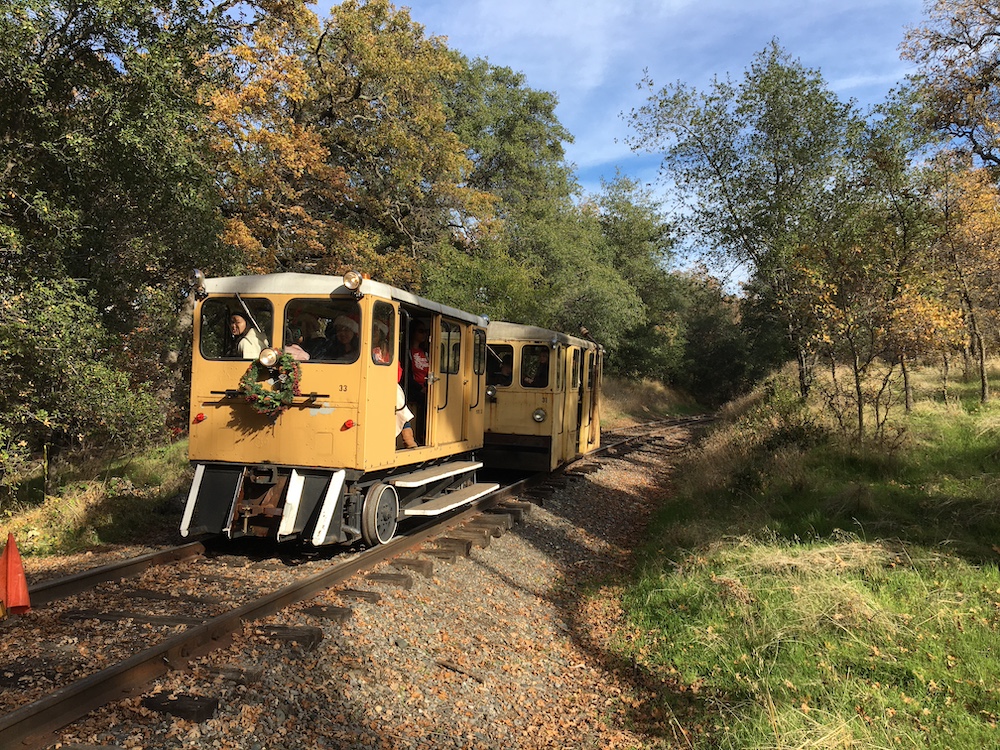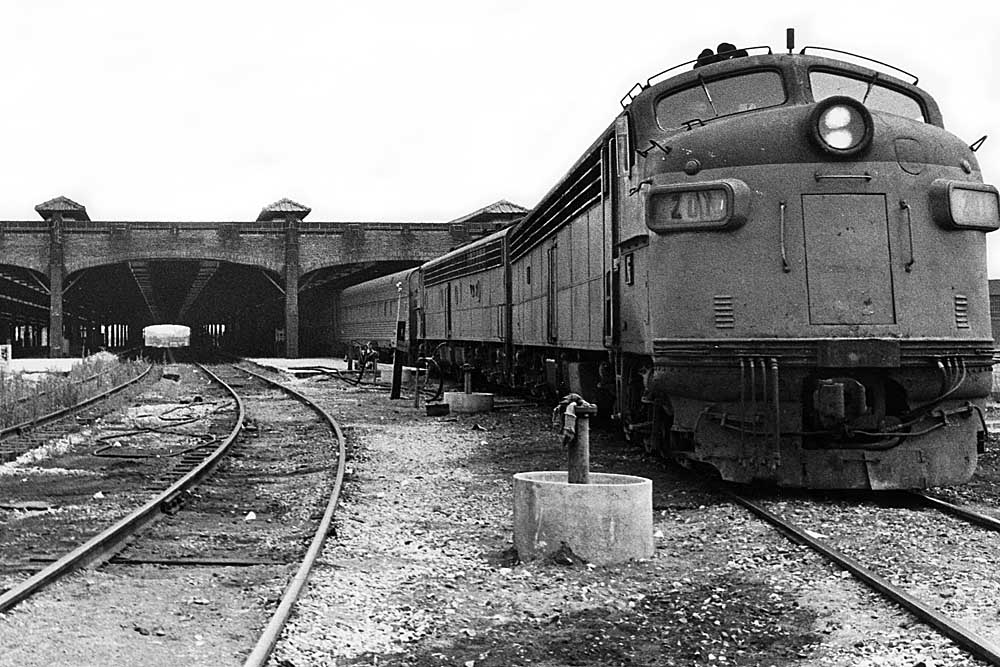But no other trains were scheduled until the NAR’s daily freight to Grande Prairie departed the next morning. And with only a single passenger aboard that summer evening 42 years ago, the railway was not in danger of losing business just because of a late start.
The train’s immediate destination was Lac La Biche, which lay 125 miles and six hours to the north. After tying up overnight at Lac La Biche, the mixed traveled the remaining 175 miles to Fort McMurray on the second day. The following morning it turned around and headed back south, stopping once again overnight at Lac La Biche. By the afternoon of the fourth day it was back at Dunvegan Yards.
Day 1: 56 cars, 1 passenger
On Sunday, June 25, 1972, train 75 departed Edmonton with 56 cars, half of which were tank cars carrying gasoline and fuel oil up to the end of the line. Also in the consist were empty Canadian Pacific boxcars destined for the grain elevators at Thorhild and a flat loaded with farm equipment bound for Boyle. On the point were two of NAR’s seven GMD1 diesels, Nos. 302 and 304. They wore the line’s classy gray, yellow, and blue livery, with the NAR diamond logo prominently displayed on the front of the short hood beneath the angled number boards. Solid, almost bricklike in shape, the 1,200-h.p. units had been designed especially for service on the light rail of Canada’s prairie branch lines and rode on A1A trucks.
Bringing up the rear was coach-caboose No. 307. This venerable piece of equipment served two distinct functions. The car’s forward section provided the conductor and brakeman with office space, a well-equipped kitchen, and bunks (complete with mosquito netting), while the rear offered decidedly no-frills accommodations for passengers. The most prominent feature of the passenger section was a large oil-burning stove. Across the aisle was a small basin, which was served by a water tank suspended from the ceiling. Instead of electric lights, kerosene lanterns—unnecessary at this time of the year, when the sun stays up so late—hung from brackets along the walls.
Because there was a bus that traveled to Lac La Biche in half the time it took the train, few people had reason to ride over this part of the NAR. As the sole passenger on this trip, I had my choice of seats. I quickly discovered they were all the same—hard and uncomfortable. But I didn’t have to put up with them for long, for as the train approached Carbondale, where the branch to Fort McMurray left the main line, the conductor came back to collect my ticket. When he heard that I’d be aboard for the entire round-trip, he invited me to join him and the brakeman up in the crew’s section. Delighted —as well as greatly relieved—I grabbed my gear, followed him forward, and soon was settled comfortably in a padded seat beside the bay window.
We paused at Egremont to set out some empty flats, and then at Thorhild to spot the CPR boxcars. After that, we didn’t stop again for more than an hour. The conductor, whose name was Carl Whiteman, used the time to prepare supper, which he kindly invited me to share. When we were finished, I helped with the cleaning up. Standing at the sink, swaying with the rhythm of the moving train, I was serenaded by the soothing clickety-clack, clickety-clack coming up through the open drain.
Day 2: New number, new personality
The next morning the train assumed a new number (77)—and also a new personality. North of Lac La Biche, the NAR served a number of tiny communities, some of which were 30 or 40 miles from the nearest paved road. The biweekly mixed train thus provided an indispensable service to the people of this isolated region. Indeed, there were so many passengers that day that a second coach-caboose was added. There was LCL freight as well, and the baggage car that rode ahead of car 307 was loaded with boxes of groceries and numerous packets of mail. There was also a washing machine, a television set, a plastic swimming pool, bags of horse feed, and canisters of propane gas.
Once again we were late getting under way, but by now I was beginning to realize that the timetable served more as guideline than gospel. Since there were no other trains anywhere else on the line, the carefully calibrated entries on the schedule (Tweedie, 9:51; Pitlochrie, 10:16) lost their some of their urgency.
By midmorning the train’s leisurely pace had carried us beyond farming country and into the muskeg, a seemingly endless wilderness of spruce, tamarack, and jack pine that was relieved only occasionally by some small settlement. Perhaps a steady diet of this kind of travel gets tedious, but the hours I spent that day and the next sitting at one of the bay windows of car 307 or standing by the open door of the baggage car watching vast stretches of wilderness roll by under an ever-changing sky had a mesmerizing, magical quality to them.
I learned from Carl Whiteman, a 43-year veteran of the NAR, that back in the days of steam the trip between Lac La Biche and Fort McMurray (or, more accurately, Waterways, the actual northern terminus of the subdivision, a few miles shy of the town of Fort McMurray) could take longer and be more of an adventure. Carl told me how the weight of the train traveling over the spongy, porous muskeg sometimes created an interesting phenomenon. A crew member standing atop one of the cars could look forward and see shiny rails stretching out ahead of the locomotive (generally one of the NAR’s 10 2-10-0 Decapods). To the rear, however, there would be nothing, nothing at all—no rails, no ties, no roadbed. Fortunately, by the time the train returned that way the tracks had resurfaced.
Late in the afternoon we eased to a halt just north of Anzac to check for hotboxes, since much of the final 20 miles to Waterways was down a 2.5 percent grade. By this time, almost 24 hours into the trip, I was being treated like a bona fide member of the crew, and as Carl climbed back aboard, he called out to me to notify the head end that all was well. I was happy to comply. “Highball, the man says,” I announced over the Motorola. “Highball, it is,” came the reply.
As soon as we reached the end of the line, the train was broken apart and the tank cars spotted so that the fuel oil and the gasoline could be transferred to barges for shipment on the Athabasca River up to the Northwest Territories. After the switching was done, I joined the crew for dinner, then headed into the surprisingly bustling town of Fort McMurray, where I searched unsuccessfully for a motel room. I returned to Waterways resigned to spending another night stretched out across the seats in the passenger end of car 307. Instead, I was invited by the crew to sleep in the NAR bunkhouse, an offer I gladly accepted.
Day 3: Delay at Anzac
Tuesday’s southbound train (No. 78) was made up of 34 cars, primarily empty tankers. Also in the consist were three boxcars of lumber and three flatcars carrying large Caterpillar earthmovers that were bound, ultimately, for Calgary. Aboard the coach-cabooses that morning was a group of local schoolchildren, who rode with us as far as Anzac. After they disembarked, we were delayed unexpectedly.
“Highball,” called Carl.
Silence.
“Highball,” he called again.
This time he got an answer. “In a moment, Carl,” replied Bob Coffin, the engineer. “Metro [the brakeman] is out picking blueberries.”
The trip south was much like our leisurely journey of the day before, with an occasional stop along the way to pick up or drop off people or supplies. Our arrival in Lac La Biche was almost two hours off the timecard, but the delay only made us appreciate Carl’s culinary efforts that evening all the more.
Day 4: Back in civilization
The fourth and final day of the trip began early, although that far north the sun is well up in the sky even at 5 a.m. One of the NAR’s roadmasters was aboard that morning, riding in the lead unit, and so there was little in the way of casual conversation over the Motorola. As if to make up for the silence, the air horn, which we had rarely heard during the previous two days, was used more often now that we were back in a populated area.
What with the oversize earthmoving equipment and the line’s 85-lb. rail, our speed was kept in check as we made our way south. We paused at Boyle to retrieve the now-empty flatcar we’d set out on the way north, and at Egremont we stopped to pick up the flats that we’d left. They had been loaded with rock and would now be taken to Watino, a town in western Alberta on the NAR main line that was the site of a recent washout. Once again I was the only passenger aboard. I felt like a seasoned railroader as I sat at my favorite perch beside the bay window, occasionally giving a casual, flick-of-the-wrist greeting to the cars that rushed past us on highway 28.
It was 1 o’clock when we reached the junction at Carbondale. Slowing to a crawl, the train clattered across the switch points and rejoined the main line. Fourteen miles and 45 minutes later we were back at Dunvegan Yards, our grand round-trip completed. We were an hour and a half late, but I had no reason to complain.
First published in Fall 2007 Classic Trains magazine.
Learn more about railroad history by signing up for the Classic Trains e-mail newsletter. It’s a free monthly e-mail devoted to the golden years of railroading.





